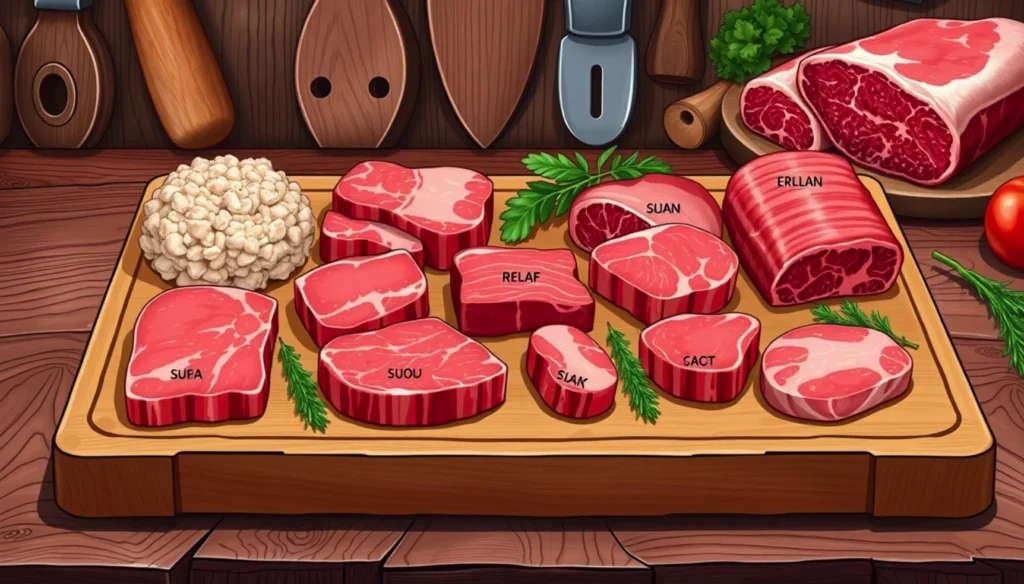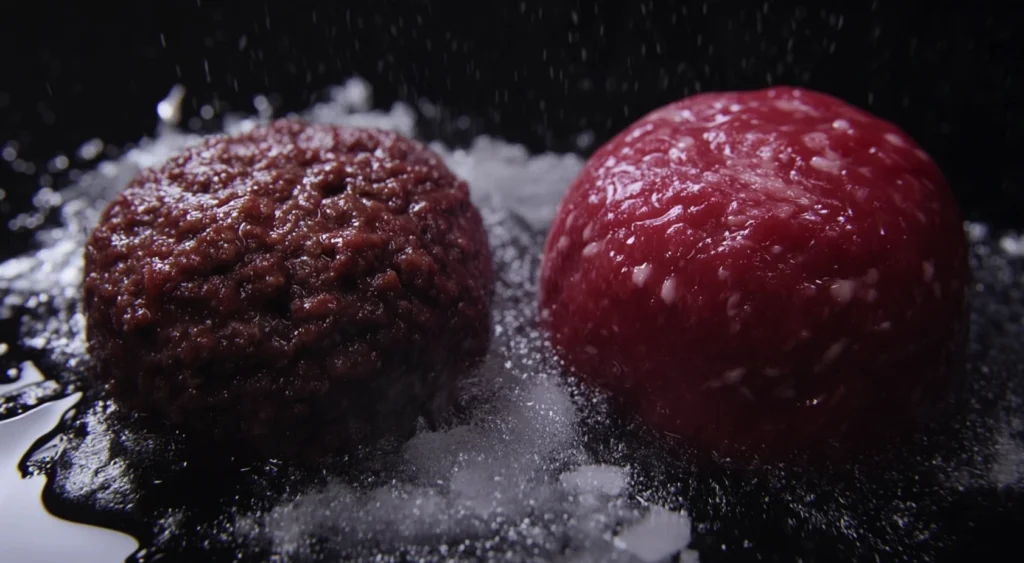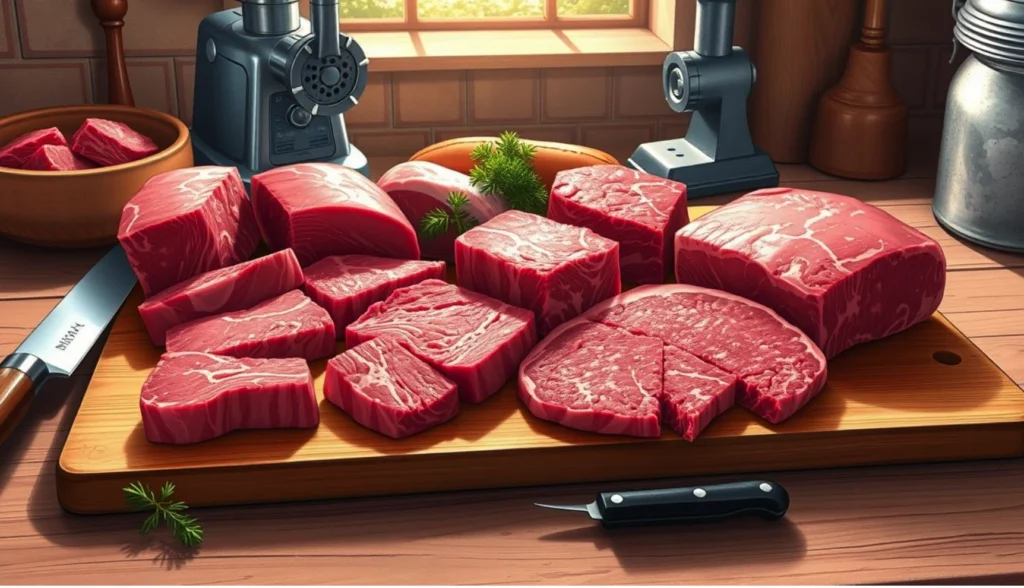I love cooking at home and exploring different meats. Ground chuck and ground beef are two examples that show how small choices can change a dish. Let’s dive into what makes each unique, so you can pick the best for your meals.
Meat choices are more than just a surface-level pick. The USDA grading system and various beef cuts offer a wealth of knowledge. This knowledge helps you choose the right meat for your recipes, making your cooking better.
Table of contents
Understanding Beef Cuts and Classifications
Knowing about beef cuts and classifications can change how you pick meat for cooking. The USDA’s grading system and different beef cut types help you make better choices. This knowledge can improve your cooking and make your dishes better.
USDA Meat Grading System
The USDA has a detailed grading system for beef. It looks at quality and what the meat is like. The main grades are:
- Prime – Highest quality with lots of marbling and tenderness.
- Choice – Excellent quality with some marbling.
- Select – Leaner cut with less marbling.
Knowing these grades helps you pick the right beef for your cooking needs.
Common Beef Cut Categories
Beef cuts fall into several main groups:
- Primal Cuts – Large, basic cuts from the carcass, like chuck, rib, and loin.
- Subprimal Cuts – Specialized cuts from the primal cuts, like ribeye or tenderloin.
- Retail Cuts – Ready-to-buy pieces, including steaks, roasts, and ground beef.
Understanding these categories helps you choose the right cut for your cooking.
Importance of Cut Selection
Picking the right beef cut is key. Each cut is best for different cooking methods and dishes. Things like tenderness, fat, and flavor matter a lot. Knowing these differences lets you make your beef dishes even better.

A detailed illustration of various beef cuts.
Ground Chuck vs Ground Beef: Key Differences
Ground chuck and standard ground beef are two types with different traits. Knowing the differences helps you pick the best for your recipes.
Ground chuck comes from the cow’s shoulder. It has a strong flavor and more fat. Standard ground beef is a mix of different cuts, often leaner ones.
The fat content is a big difference. Ground chuck has 15-20% fat. This makes it taste richer and more beefy. Standard ground beef has 10-15% fat, making it leaner.
The fat content affects how you use these meats. Ground chuck is great for burgers, meatballs, and meatloaf. It stays moist and tastes better because of its fat. Standard ground beef is better for tacos, chili, or pasta sauces because it’s leaner.

Ground chuck and ground beef.
“Choosing the right ground meat for your recipe can make a significant difference in the final outcome.”
Knowing the differences between ground chuck and standard ground beef helps you choose better for your cooking.
The Unique Properties of Ground Chuck
Choosing the right ground meat is key for a great burger. Ground chuck is a standout for its fat content, texture, and flavor. It’s different from regular ground beef.
Fat Content and Distribution
Ground chuck’s fat content is around 20%. This fat is spread evenly. It makes burgers juicy and tasty, without being too greasy.
Texture and Consistency
Ground chuck has a coarse texture. This texture keeps burgers tender and enjoyable. It also holds its shape well when cooked, making it perfect for burger patties.
Flavor Profile
Ground chuck has a rich, beefy taste. Its fat and muscle fibers add depth of flavor. This makes it great for burgers and other beef dishes.
“The fat content and texture of ground chuck make it an unbeatable choice for burger patties that are juicy, flavorful, and perfectly cooked every time.”
Standard Ground Beef Composition
Standard ground beef is the most common type found in stores. It’s great for many dishes, like burgers and chili. But what’s in it?
It’s made from different beef cuts, like chuck, round, and sirloin. The mix includes lean meat and fatty parts. This mix has 15% to 20% fat, making it juicy and flavorful.
Standard ground beef is mostly muscle proteins. These proteins help with its texture and nutritional value. They make it a good source of protein.
Exploring the Fat Content
The fat in standard ground beef is important for its taste and texture. It has about 20% fat, making it moist and tender. This is different from ground chuck, which is leaner and firmer.
“The fat content in standard ground beef is a key factor that sets it apart from other ground beef varieties, like ground chuck. It’s this balance of lean muscle and fatty trimmings that makes standard ground beef such a versatile and popular choice.”
Knowing what’s in standard ground beef helps you choose the right one for your recipes. Whether it’s for a classic burger or something new, knowing the fat and protein content helps you get the right taste and texture.
Fat Content Comparison and Nutritional Values
Ground chuck and standard ground beef differ in fat content and nutrition. Let’s explore these differences.
Protein and Fat Ratios
Ground chuck has more fat, from 15% to 20%. Standard ground beef has less, about 10% to 15%. This affects their nutritional value and how they cook.
Caloric Content Breakdown
Ground chuck has more calories because of its fat. A 4-ounce serving has about 270 calories. Most of these calories come from fat. Standard ground beef has fewer calories, around 220 to 240 per 4-ounce serving.
Essential Nutrients
- Both ground chuck and standard ground beef are great for protein. Each serving has about 20 grams.
- Ground chuck might have more iron and zinc. These minerals help our bodies work well.
- Its higher fat also means more vitamin E and omega-3 fatty acids. These are good for our health.
Ground chuck has more fat and calories but is still nutritious. It has a unique taste and many nutrients. Choose based on your health goals and taste preferences.
Best Cooking Applications for Ground Chuck
Ground chuck is a versatile ingredient that works well in many dishes. It has a rich flavor and the right mix of fat and lean meat. This makes it perfect for making tasty burger patties and delicious meatloaf.
To get the best results when cooking with ground chuck, consider these tips:
- For juicy, flavorful burger patties, gently form the ground chuck into loosely packed balls. Then, lightly press them into round, even shapes. This helps prevent the patties from becoming dense and tough during cooking.
- When making meatloaf, mix ground chuck with other ground meats like sirloin or round. This creates a balanced and textured dish. The fat in ground chuck adds moisture and richness to the meatloaf.
- Avoid over-mixing or compacting the ground chuck when preparing meatballs or other ground meat dishes. This can result in a dense, tough texture. Instead, gently combine the ingredients and handle the meat with a light touch.
By understanding the unique properties of ground chuck and applying these tips, you can unlock its full potential. You can make everything from classic burger patties to comforting meatloaf.
“Ground chuck is the ultimate choice for creating burgers and meatloaves that are juicy, flavorful, and perfectly textured.”
Ideal Uses for Standard Ground Beef
Standard ground beef is a kitchen superstar. It’s great for chili and meatballs. It makes many dishes better.
It’s perfect for comforting casseroles or trying new flavors. Ground beef is a solid base for your cooking.
Versatile Cooking Methods
Ground beef can be cooked in many ways. You can sauté, brown, or crumble it. It’s great in soups, stews, and sauces.
It’s also good in baked dishes like meatloaf or shepherd’s pie. It soaks up flavors well.
Recipe Adaptations
Ground beef is easy to swap in recipes. You can use ground chuck instead of ground beef. This makes it versatile for many dishes.
So, ground beef is great for family casseroles or new recipes. It makes meals tasty and easy to make.
Price Points and Value Comparison
Ground chuck and ground beef have different prices. Ground chuck, from the cow’s shoulder, costs more. This is because it’s leaner and has better flavor and texture.
Ground chuck tastes richer and more robust than ground beef. It’s also juicier and tender. This makes it great for burgers and meatballs.
Even though ground chuck is pricier, its quality is worth it. Whether it’s better than ground beef depends on what you like and what you’re making.
“Ground chuck’s higher fat content and distinctive flavor profile make it a worthwhile investment for those seeking exceptional quality and taste in their ground meat dishes.”
Think about what you want from your meals. Decide if ground chuck’s extra cost is worth it. Knowing the differences helps you choose what’s best for you.
Storage and Handling Guidelines
Handling and storing ground chuck and ground beef right is key for food safety and quality. Whether you’re making a tasty burger or a savory meatloaf, knowing the best storage and handling tips is crucial.
Proper Storage Methods
For the best freshness and safety, storing ground chuck and ground beef correctly is vital. Here are some important guidelines:
- Refrigerate ground chuck and ground beef at 40°F (4°C) or below as soon as possible after buying.
- Keep the meat in its original packaging or put it in an airtight container or resealable plastic bag.
- Avoid leaving ground meat at room temperature for more than two hours (or one hour if it’s over 90°F/32°C).
- Freeze ground chuck or ground beef if you won’t use it in 1-2 days. Frozen meat can last 3-4 months.
Food Safety Considerations
Food safety is a big deal when comparing ground chuck to ground beef. Here are some key things to remember:
- Always use separate cutting boards and utensils for raw ground meat and other foods to avoid cross-contamination.
- Cook ground chuck and ground beef to an internal temperature of 160°F (71°C) to kill harmful bacteria.
- Throw away any ground meat that’s been at room temperature for more than two hours (or one hour if it’s over 90°F/32°C).
- Don’t refreeze ground meat that’s been thawed before, as it can be unsafe.
By sticking to these storage and handling tips, you can keep your ground chuck and ground beef fresh, safe, and ready to make delicious dishes.
Making the Right Choice for Your Recipe
Choosing between ground chuck and standard ground beef can change your dish a lot. Ground chuck has more fat and a special texture. It’s great for many recipes. Standard ground beef is good for a wide range of dishes.
Think about what you want your dish to be like. Ground chuck is perfect for meatballs, burgers, or meatloaf. It’s juicy and flavorful because of its fat. Standard ground beef is better for tacos, chili, or casseroles because it’s leaner.
Ground chuck’s texture is great for dishes that need a meaty feel. Standard ground beef works well for lighter textures.
“The right choice between ground chuck and standard ground beef can make all the difference in your culinary creations.”
It’s all about what you like and what your recipe needs. Try both and see which one works best for you.

A detailed illustration of various cuts of beef.
Conclusion
We’ve looked into the differences between ground chuck and standard ground beef. They are both great for cooking, but they’re best used in different ways.
Ground chuck is perfect for juicy, tasty dishes like burgers and meatballs. It has more fat, which makes it extra juicy. Standard ground beef is good for many recipes, like tacos and casseroles.
Try using both ground chuck and beef in your cooking. This way, you can find the best one for your favorite meals. Knowing the differences will help you make your dishes even better.
FAQ
What is the difference between ground chuck and ground beef?
Ground chuck and ground beef are both ground meat. But, they come from different parts of the beef. Ground chuck is from the chuck cut near the shoulder. It has more fat, making it taste richer and juicier.
What is the USDA meat grading system, and how does it affect the quality of beef?
The USDA grading system checks beef quality. It looks at marbling, maturity, and color. The top grade is USDA Prime. This means the beef is tender, juicy, and tastes better.
What are the common beef cut categories, and how do they differ in terms of culinary applications?
Beef cuts are divided into chuck, rib, loin, and round. Each is good for different dishes. Chuck is great for ground meat and stews. Rib steaks are tender and flavorful. Round is best for roasts.
How does the fat content of ground chuck differ from standard ground beef?
Ground chuck has more fat, 15-20%. Standard ground beef has 10-15% fat. This extra fat in chuck makes it juicy and flavorful, perfect for burgers and meatloaf.
What are the unique properties of ground chuck that make it a preferred choice for certain dishes?
Ground chuck’s fat and flavor make it great for burgers and meatloaf. The fat keeps it moist. Its flavor enhances the dish. It’s also easy to shape into patties or loaves.
What is the typical composition of standard ground beef?
Standard ground beef comes from chuck, round, and sirloin. It has less fat, 10-15%. This makes it leaner but versatile for many recipes.
How do the nutritional values of ground chuck and ground beef compare?
Ground chuck has more fat and calories. But, it’s also higher in protein. Both are good for nutrients, but chuck might have more iron and zinc.
What are the best cooking applications for ground chuck?
Use ground chuck for dishes where fat enhances flavor and texture. It’s perfect for burgers and meatloaf. It also works well in chili or bolognese sauce.
What are the ideal uses for standard ground beef?
Standard ground beef is versatile for many recipes. It’s leaner, making it good for tacos, meatballs, or stuffed peppers. It can replace chuck in many dishes.
How do the price points of ground chuck and ground beef compare, and which one is considered better?
Ground chuck costs more due to its fat and cut. But, its flavor and texture are worth it. Many chefs prefer chuck for its unique qualities.
What are the proper storage and handling guidelines for ground chuck and ground beef?
Store both in the fridge at 40°F (4°C) or below. Use within 1-2 days or freeze. Always follow food safety to avoid contamination and ensure proper cooking.
How do you decide when to use ground chuck versus ground beef in a recipe?
Choose based on the dish and your taste. Use chuck for burgers and meatloaf. Opt for beef for leaner dishes like meatballs or tacos. Pick the meat that fits your recipe best.

